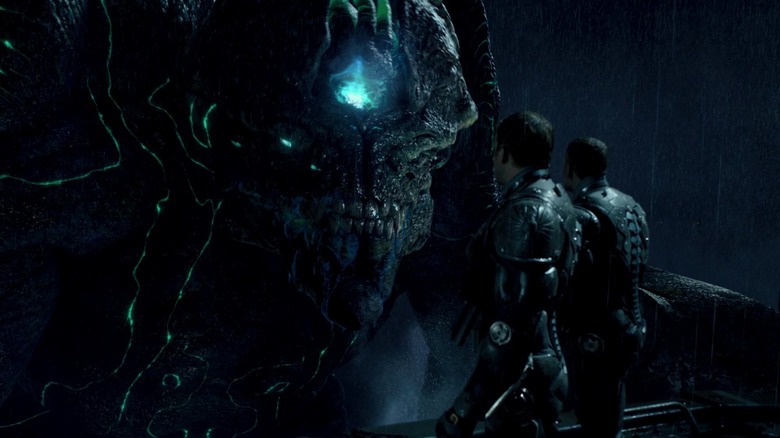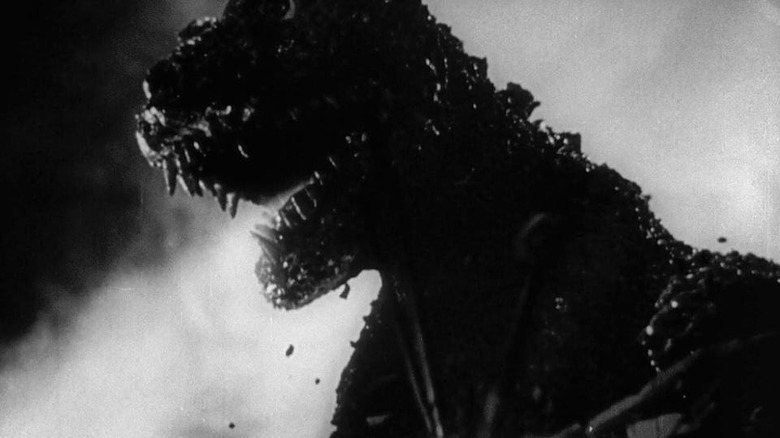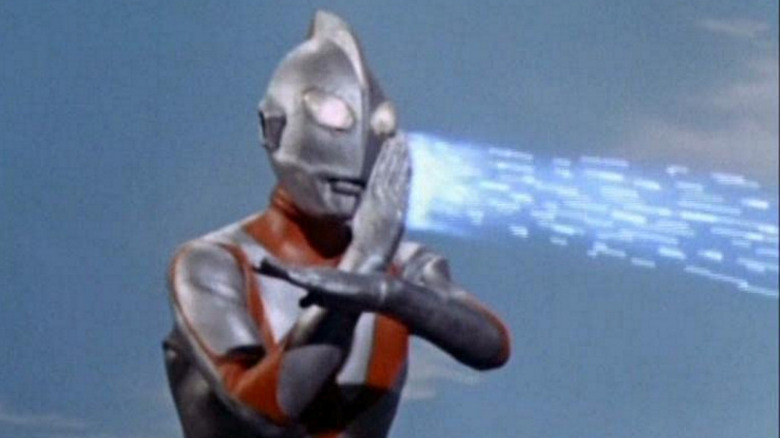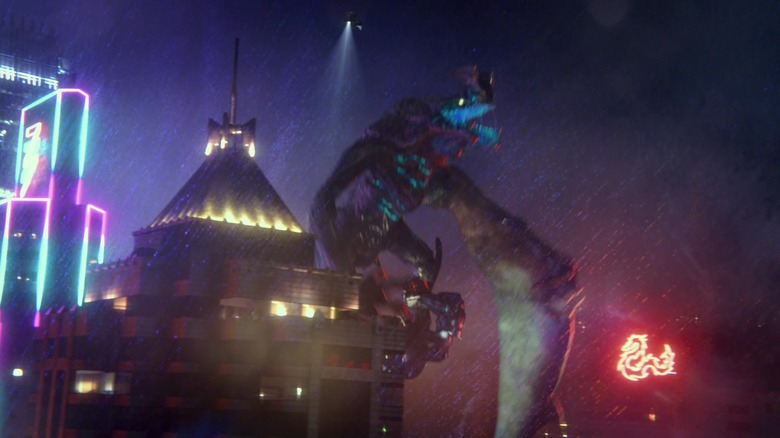Pacific Rim Kept A Key Part Of Its Old-School Kaiju Movie Roots
"Pacific Rim" was a turning point in Guillermo del Toro's career. He left "The Hobbit" after delays at MGM ate into his schedule. His passion project "At the Mountains of Madness" had fallen through due to a perceived lack of commercial viability. The filmmaker could feel the momentum he had worked so hard to build slipping away. So del Toro had to prove to his fans and to himself that he could still make movies (and quickly). So he changed practices. Before "Pacific Rim," the director had never made a movie in less than 115 days. His crew did "Pacific Rim" in 103. Before "Pacific Rim," he had labored over the individual movements of his actors to create the right aesthetic effect. But the cast of "Pacific Rim" were encouraged to improvise, with the help of a multiple-camera set-up.
Despite the speed at which "Pacific Rim" was made, the film retains del Toro's eye for detail. Color choices convey character and setting. The inner cells of the robotic Jaegers were brought to life with complex puppetry that the cast and crew found exhausting to operate. Most important of all were the kaiju themselves, for del Toro has always loved his monsters. The filmmaker and his crew used the visual motif of bioluminescence to unify the kaiju, suggest their underwater origi,n and provide cool effects for night battles. They chose simple, readable designs over complex ones to ensure striking silhouettes. But it was one choice above all that they made which grounds "Pacific Rim" in a larger filmmaking tradition, going all the way back to "Gojira" in 1954.
The birth of suitmation
Directed by Ishiro Honda, "Gojira" bears the mark of two Hollywood films. The first was "King Kong," whose titular character (created by stop-motion animator Willis O'Brien) is an incredible feat of special effects design that still holds up today. The second was "The Beast From 20,000 Fathoms," whose creature was designed by O'Brien's student Ray Harryhausen. Producers greenlit "Gojira" on the strength of the box office numbers of "Beast" in Japan. But it was "King Kong" that the creators of "Gojira" really loved. Eiji Tsuburaya, who led the team producing special effects for "Gojira," studied the movements of the great ape again and again. He sought to bring some of that life to his own creature. But while Tsuburaya's crew were smart and resourceful miniature designers and effects makers, they did not have the time or budget for high-quality stop motion.
The creators of "Gojira" turned to a less glamorous solution: rubber suits. Their monster would be a man in a costume destroying tiny buildings while shot from a low angle. The result was technically inferior to what O'Brien accomplished in "King Kong." A suit does not have the range of articulation of a stop motion model. Its face is plasticine, not malleable. Despite these limitations, "Gojira" was a success. Its miniaturized rubble depicted scenes of bombing and horror that audiences, at the time, recognized themselves from real life. The story remains relevant today, addressing nuclear testing and scientific ethics. Even the solidity of Gojira himself adds something to the film. He is certainly not as expressive as King Kong, but he is fully convincing as an insurmountable god of destruction and fear.
The rise of Ultraman
The success of "Gojira" began a kaiju movie boom. "Gojira" studio Toho Co. produced memorable film debuts for creatures Mothra and Rodan before recycling them into the greater "Gojira" franchise. Copycats like Daiei Film's "Gamera" sought to bring its titular creature to life with mechanical rather than suit-based effects, to mixed results. ("Gamera" would have its revenge in the 90s with a trilogy of movies still considered to be a high water mark of the genre.) Meanwhile, Eiji Tsuburaya continued to push the boundaries of what was possible with suitmation. His producers requested that he bring the special effects he helped pioneer to the scrappy medium of television. The result, after much experimentation and compromise, was "Ultraman," the story of a friendly alien able to grow to enormous size and defend the earth from a new monster each week.
Like "Gojira," "Ultraman" (and its predecessor "Ultra Q") made compromises. Rendering the world of kaiju on a weekly schedule meant shortening fights, streamlining special effects, and cutting costs at every opportunity. But "Ultraman" was also a true labor of love. No matter how much money Tsuburaya's crew managed to save, the production of "Ultraman" was so time-intensive that they were always days behind schedule. Every week was a fight against the deadline to satisfy the team's high standards. Despite these challenges, "Ultraman" and its successors set a new standard for effects animation on television. At the same time, they helped codify suitmation as the definitive technique for representing kaiju on screen.
The meaning of kaiju
It was this tradition of excellence that del Toro sought to emulate in "Pacific Rim." In a tip of the hat to these earlier films and television shows, the kaiju were designed to fit the proportions of a human wearing a rubber suit. "Even for the giant crustacean monster," del Toro told Den of Geek in an interview, "you could execute that monster as a suit." The special effects of "Pacific Rim" are realized at a level of budget and fidelity that Eiji Tsubaraya and his staff could only dream of. But del Toro and his team made the decision that the artifice of "Gojira" and "Ultraman" was worth preserving, even when the special effects of today no longer required it.
Like del Toro, other artists have been wrestling recently with whether to depict kaiju as creatures or suits. Leading the charge is the anime series "SSSS.Gridman," produced by Studio Trigger under the supervision of Tsuburaya Productions. Director Akira Amemiya chose to represent both Gridman and his kaiju adversaries as 3D models, rendered by 3D specialist studio Graphinica. Amemiya goes even further than del Toro in pursuit of homage, confirming in an interview with Manga Hack that "we didn't want [kaiju] to move in ways that you couldn't while wearing a suit." Amemiya and his team sought to replicate the aesthetic appeal of kaiju as "objects," rather than truly living creatures. An apt decision for a series that is as much about the solace and potential dangers offered by nostalgia as it is about punching giant monsters in the face. Trigger and Graphinica would further refine this process with "SSSS.Dynazenon," the sequel to "Gridman."
The cancellation of the apocalypse
Other kaiju productions have tried to capture the appeal of kaiju as animals, rather than suits. The recent "Godzilla: Singular Point" spends much of its time creating a grand unified physics theory of "Gojira" across media, but still finds time for kaiju psychology and biology. "We depicted them as living creatures that try to avoid the buildings in their way as much as possible," said director Atsushi Takahashi in an interview with Anime News Network. "When their enormous bodies make contact with the buildings, they end up getting destroyed." Similarly, writer Toh Enjoe chose to interpret the title creature via the lens of "what could be reexamined through the perspective of modern biology." Roland Emmerich tried and failed to create a "practical" Gojira in his 1998 film. "Singular Point" instead aims to place the whole of the "Gojira" franchise within a physical cosmos absurd enough to contain it, and it just about succeeds.
Just like Tsuburaya's team worked long hours to push the boundaries of Japanese effects animation with "Gojira" and "Ultraman," del Toro sought to express his love of giant monsters with "Pacific Rim." To its audience, "Pacific Rim" offers a meal that seems almost decadent in its willingness to explore tangents that modern blockbusters would save for sequel fodder. To its predecessors, "Pacific Rim" lovingly replicates past innovations without being bound by them, all "to provoke awe and love for these creatures and robots," in del Toro's words. Part of me longs for a return to the darkness of the original "Gojira," which has only ever been glimpsed sporadically since. But if the future of kaiju is a party, a meetup for "celebrity figures...outlandish and beautiful," I trust folks like del Toro, Amemiya and their cohorts to make it a good one.




